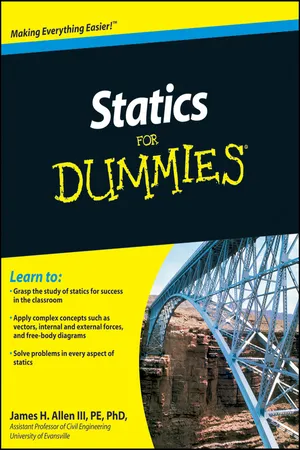Part I
Setting the Stage for Statics
In this part . . .
This first part introduces you to the basic concepts of mechanics in engineering and the sciences, as well as the differences between the basic fields. You also pick up the basic assumptions you need when working statics problems. I explain the two primary systems of units (U.S. customary and metric) and introduce you to the base units of each system. Finally, I review basic algebra, geometry, trigonometry, and calculus, all of which you encounter frequently in statics.
Chapter 1
Using Statics to Describe the World around You
In This Chapter
Defining statics and related studies
Introducing vectors
Exploring free-body diagrams
Looking at specific applications of statics
Statics is a branch of physics that is especially useful in the fields of engineering and science. Although general physics may describe all the actions around you, from the waving of leaves on a tree to the reflection of light on a pond, the field of statics is much more specific.
In fact, statics is actually a part of most physics courses. So if you’ve ever taken a high school or college physics course, chances are that some of the information in this book may seem vaguely familiar. For example, one of the first areas you study in physics is often Newtonian mechanics, which is basically statics and dynamics.
Physics classes typically cover a wide range of topics, basically because physics has a wide range of applications. Conversely, a statics course is much more focused (which doesn’t necessarily mean it’s simple). Whoever said that the devil is in the details may well have been talking about statics.
Before you panic, close the book, and begin questioning why you ever thought you could understand statics, let me reassure you that just because statics isn’t always simple doesn’t mean it’s always difficult. If anything, statics does happen to be very methodical. If you follow some basic steps and apply some basic ideas and theory, statics actually can become a very straightforward application process.
Now, about those details . . .
What Mechanics Is All About
The study of the world around you requires knowledge of many areas of physics, often referred to as mechanics. The mathematician Archimedes of Syracuse (287–212 BC) is often credited as being the first person to systematically study the behavior of objects by using mechanics and is attributed with saying “Give me a place to stand and I will move the Earth.” This statement, while rather grandiose for his time, proves itself to be at the very heart of the study of mechanics (and, more specifically, statics).
Mechanics refers to one of the core areas of physics, usually concentrated around the principles of Sir Isaac Newton and his basic laws of motion, and is an area of concentration that engineers and scientists often study in addition to basic physics classes. These courses develop the core curriculum for many basic engineering programs and are usually common classes across all disciplines. Specific engineering disciplines may require additional courses in each of these core areas to teach additional (and often more advanced) topics.
One of these core areas is in the area of statics, which isn’t the study of how you should move across a shag carpet in order to apply a jolt of electricity to your younger siblings or how to implement the latest hygiene techniques to avoid those dreadful bad hair days. In this book, I define statics as the mechanical study of the behavior of physical objects that remain stationary under applied loads (which I discuss later in this chapter). The behavior of the floor beams in your hous...


